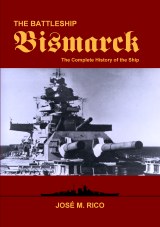 |
Home Intro Technical History Crew Models Gallery Kriegsmarine Archives More Forum
 UPDATES UPDATES |
Text Volume
from a copy of the original document provided courtesy of William J. Jurens.
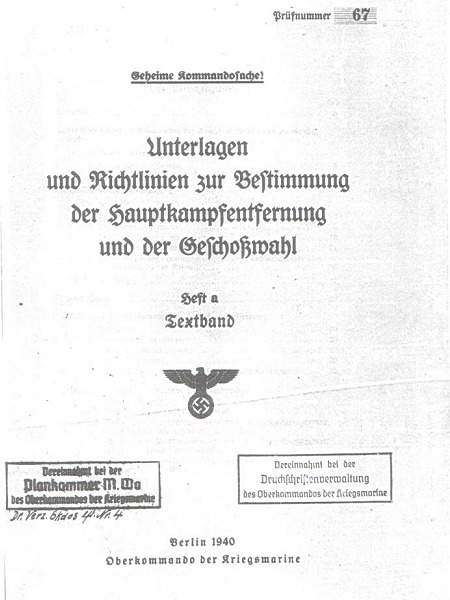
I. Introduction.
II. The Foundations for the determination of battle distance and projectile selection.
-
A. Armor plate material.
-
1. Homogeneous material.
2. KC-material.
B. The Armor Arrangement.
C. The Shells.
-
1. General comments.
2. Armor-piercing shell.
3. High explosive shell with base-detonating fuze.
4. High explosive shell with nose-detonating fuze.
5. Compilation of the introduced projectiles and general aspect concerning the deployment of these projectiles.
D. The guns.
IV. Guidelines for the determination of the main battle distance.
-
1. Introduction.
2. The lower penetration zone.
3. The upper penetration zone.
4. Hit predictions.
5. Determination of the main battle distance and shell selection.
1. Purpose.
First of all, the presentation of this special addition is to reemphasize the requirements that are essential for the proper and correct deployment of the ships’ artillery, i.e., these documents are to allow:
-
a) the determination of a favorable engagement distance based on penetration performance and strength using factually correct data and
b) to enable the selection of correct projectile types.
2. Implementation.
The knowledge of an advantageous deployment situation can produce the desired gunnery range that should be achieved when possible, but it also provides factual direction for appropriate tactical behavior in determining future battle distances. However, these data should not lead to a total reliance on past experience. As a matter of fact, other viewpoints that are based on observational relationships, and also for tactical reasons, may suggest that other distances for battle should be chosen. See the conclusions at the end of this document.
Furthermore, one must consider that the supplied data should be utilized with a certain degree of caution, since, firstly, they are based on reports regarding unfamiliar materials, particularly since the available data are very sparse concerning foreign armor plate and the penetrating performance of shells. Moreover, even with the best knowledge of our own material, the values provided, in a sense, are only mean values that are a good judgment, but really only a [best] guess. In addition, one must realize that chance plays a significant role, especially with regard to the action and impact angle of hits.
Since foreign materials have to be entered into the equation, the comparative analysis considered in the calculations of “best” known material are made based on the quality of our own material. This is done in order to somewhat allay disappointments [based on the underestimation of foreign shells and armor – Editor]. We are entitled to the prediction that our material is the best, since, based on our experience and the available data, we assume that, now as before, we lead the world in the field of armor and shell materials.
Conclusion:
In order not to expand this administrative bulletin to a cumbersome degree, it is limited to the European states; furthermore, it deals only with the major calibers used aboard ships.
1. The Homogeneous material (Wh. n/A. and Ww. n/A.)
One must differentiate between homogeneous armor plate and the so-called KC-armor plate. Homogeneous armor is primarily used in horizontal protection (deck armor), splinter bulkheads, fragmentation shields on deck, and for torpedo bulkheads. Before the [First] war, the so-called low percentage nickel steel was utilized for this purpose, for which it was a quite soft and deformable chrome-nickel steel of about 55 kg/mm² tensile strength. In addition to this material, the so-called Quality 420 steel was used for special requirements. This material was a chrome-nickel steel alloy of about 80 kg/mm² tensile strength. The plasticity of this material was not as effective as the lower-percentage nickel steel. However, by virtue of its higher tensile strength it was superior against direct penetration by shells as well as against fragments.
After the war, a special chrome-nickel steel was developed that totally replaced the low-percent nickel steel and the Quality 420. This new material is produced primarily in two tensile strengths:
-
a) with approximately 70 kg/mm² tensile strength (Ww. n/A.), e.g., for torpedo bulkheads and
b) with approximately 85 kg/mm² tensile strength (Wh. n/A.) for the appropriate deck armor and light vertical armor.
2. The KC material.
The principal armor protection for ships against direct hits, as far as the armor exceeds a certain thickness (approximately 100 mm), are plates of the so-called KC material (= Krupp-cemented). Here, we are dealing with plates that are hardened by a one-sided carburization (cementation) process that reaches glass-hardness by subsequent surface treatment, but does not show readily detectable hardening beyond one third of the plate thickness. The remaining two thirds of the plate thickness are tough [ductile] and exemplify the pre-war composition in their properties and resemble approximately the Quality 420 homogeneous plates described above in their physical/chemical characteristics. The hardness characteristics of these plates are shown in the following diagram:
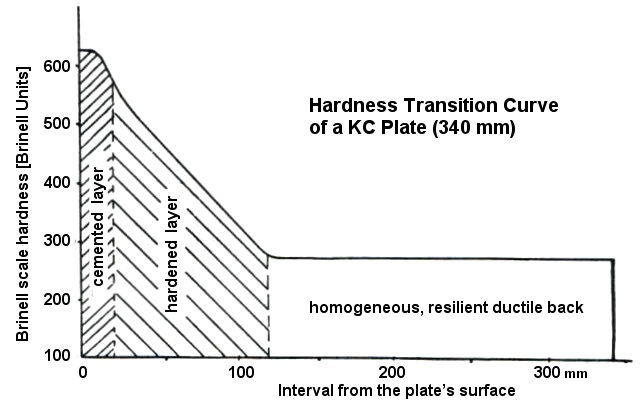
In the following picture, a breaking [fracture] test of a 320 mm thick KC plate shows clearly that the armor does not have a homogenous characteristic. At the extreme upper end a vitreous area about 1 cm thick can be recognized, followed by the hardened one-third plate-thickness section and the posterior two-thirds thickness of the ductile section.
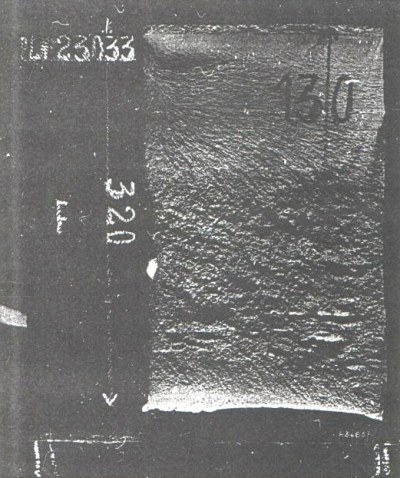
After the [First] war, changes in the method of experimental analysis made it possible to considerably upgrade the ballistic strength [resistance] of KC plates. The strength of the backside, as in the case of the homogeneous plate material, could also be increased without affecting the ductile strength [values].
Based on the experience of the War, and as a result of ongoing weapons development, the armor protection was primarily improved according to the following perceptions:
- Against impacts that can readily hit the armored deck from great distances and with large incoming angles.
- Against bomb attacks.
Despite reinforcing the main armor deck, it cannot be made so strong that it can repel projectiles that hit the armor deck from maximum distances. Such an extensive reinforcement of the armor deck would shield large parts of the ship even against the heaviest armor-piercing explosive shells striking at steep descending trajectory angles, but it is not possible for reasons of weight. It will only be possible to increase the distance at which the horizontal protection can still be penetrated.
Just as it is impossible to afford full protection at long distance ranges against the heaviest shells, it is just as impossible to offer absolute protection against threats from the air, since the heaviest armor-piercing bombs that are being built and deployed at this time are capable of penetrating the strongest armored deck. The requirement [for the latter], however, is great dropping height or rocket propulsion. The effectiveness of these bombs is seriously impaired due to the low probability of hits from great heights and the relatively small amount of explosives (~6% explosive charge) [these AP bombs contain]. It is, therefore, considered appropriate that the uppermost suitable deck be armored (~50 mm) so that normal thin-walled explosive bombs (~50% explosive charge) are fragmented, but that thick-walled explosive bombs with considerably less explosive load (~25%) can penetrate this deck [and have their fuze process initiated]. These [semi] armor-piercing bombs, which resemble our high explosive shells with base detonating fuzes, can then detonate in the ship’s interior, but above the main armored deck. Only on rare occasions, e.g., as in hits adjacent to the funnel shafts of heavily armored ships, could such bombs destroy vital parts of the ship.
In order to contain the effects of explosions and splinters from such bombs and shells detonating above the main armored deck, all the newest heavy ships should have longitudinal and transverse bulkheads installed in the midships areas that are made from 30 mm Wh material. Furthermore, the funnels are to receive splinter protection with 30 mm Wh material above the upper deck.
As described above, the armored deck can now only be penetrated by such armor-piercing bombs that contain ~6% explosive charges. The effect of such a bomb resembles about the effect of a high explosive shell with base detonating fuze of equal weight.
To make the uppermost suitable deck strong is also advantageous for reasons relating to the ship’s overall longitudinal structural strength. And while achieving longitudinal strength, it also protects the compartments below from the effects of explosive bombs without retardation [fuzes].
The French and English have taken a fundamentally different course of action with “Dunkerque”, and, respectively, “Nelson”. They have especially strengthened the deck above the location of our armored deck [the battery deck], which lies along the upper edge of the belt, and they have ordered only a weaker armored deck or splinter shielding below this deck. In this manner, the action of heavy bombs with time delay and heavy artillery impacts on the armored deck will be largely held off the ship. The lightly armored deck below the heavily armored deck is supposed to catch shell fragments and armor plate wreckage. This armor arrangement has a disadvantage in that the deck armor cannot be brought to bear if it [the ship] is hit by artillery below the level of the heavily armored deck. A comparison of this armored deck arrangement with that of the German system speaks very favorably for the latter.
Conclusion:
Reports regarding the strength requirements of foreign armor material and the foreign armor arrangements are especially important, because they influence our munitions development and they also, as will be elaborated at the end, lead to the determination of our most favorable battle distances. All that can be gathered as factual information about this experience is to be transmitted to the Naval High Command without delay so that it may be properly evaluated.
In this section the most recent developments in shells will be briefly explained because this knowledge is of particular value in evaluating the research and development by foreign states of unusual materials.
1. General Comments.
During the war [WWI], and particularly in the post-war period, shells were first of all improved in the following regard:
-
a) The range and impact velocities (terminal velocities) were increased by improvements in external form [design].
The projectile’s length (L) was greatly increased, [and] for the head radius a 10 D with 0º incline angle [ogive/crh] was recognized as the most practical external form, (see sketch below: development of the armor-piercing shell).
b) The penetrating characteristics were markedly improved by increasing of the shell weight in relation to the improvement of the external configuration. The efforts to increase penetration effectiveness led to a combination of increases in the projectile’s weight in relationship with improvements in its external design form.
c) The various shell types were ballistically standardized in order that armor-piercing shells, high explosive shells with base detonating fuze, and high explosive shells with nose detonating fuze could all be fired using a single firing table [for calculations]. The manufacture of projectiles is fundamentally different for the three types of shells, and this is determined by their characteristics (HE shell with nose detonating fuze, HE shell with base detonating fuze, and AP shell). Thus, their basic purpose deviates from one another, and therefore, so too their ballistic properties. After many experiments, it was possible to unify [standardize] the 3 shell types, despite their individual ballistic characteristics, into a single group so that they can be fired using a single firing data table.
2. The armor-piercing shell (Panzersprenggranate).
a) Development and construction.
The effectiveness of penetrating force of the armor-piercing shell was considerably improved as described in "improvement of external form" and "increase in projectile weight".
Further improvements were achieved through the following measures:
-
- By the introduction of stronger and heavier [piercing] caps.
- By hardening of the point of the caps in association with an improved cap form.
- By improvements of the annealing process of the shell. The new annealing process of the projectile is made so that the point of the nucleus of the shell is as hard as possible, but the cavity in the shell remains surrounded by ductile [tough] material.
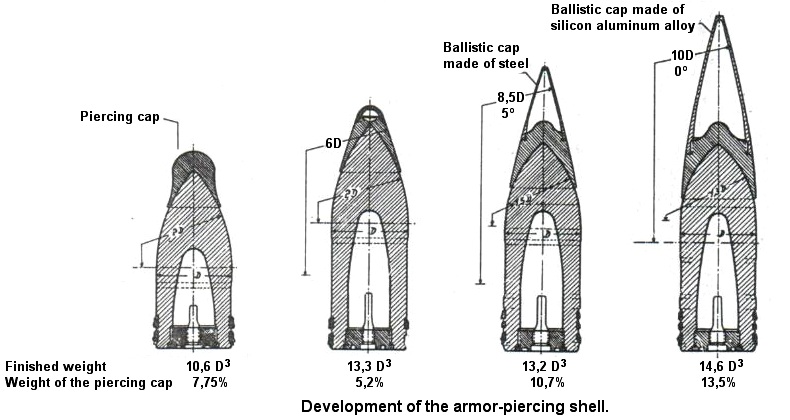
b) The effect of the armor-piercing shell.
The task of the AP shell is to achieve as good a detonation effect as possible, even in interior spaces that are protected by heavy armor.
Observations of the effect of the AP shell are differentiated into the following principal categories:
-
1. The effect of the intact shell ["heil"] that detonates at the target after penetration of the plate.
2. The effect of the shell which disintegrates during penetration of the armor.
3. The effect of the incoming shell at a flat angle.
4. There is no effect behind the plate. The plate offers complete protection.
The effect of the intact perforating shot, whereby the shell detonates fully behind the plate, i.e., on target, is by far the maximal effect that is obtained with an AP shell. The full detonation is obtained only if the cavity containing the explosive charge remains intact during penetration of the plate. The limits for such an effect can be seen in the penetration curves – red curve - (details about the use of the curve, see Section IV).
The following effects take place during full detonation:
-
The explosive effect,
The splinter effect including the effect of armor plate wreckage,
The incendiary effect,
The smoke and gas effect and, in cases where a combat substance is incorporated in the shell, then also
the combat substance effect [e.g., tear gas, phosphorus].
The splinter effect is considerably more extensive than the explosive effect. Protection against splinters from an AP shell, whose number and weight is obtained from the shot table, can be derived from the following curve.
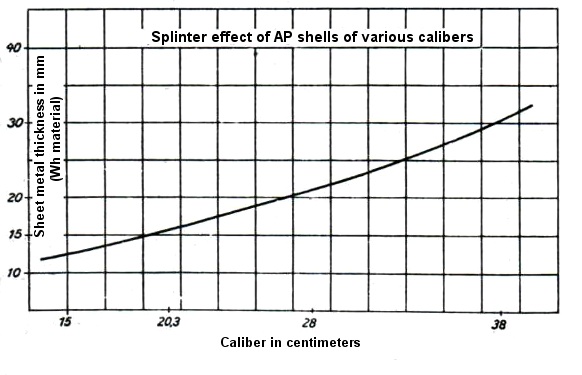
The sheet metal thickness (Wh material) that still affords complete protection against splinters from a given shell can be obtained from the curve. However, it must be emphasized that the values of the curve were generated by [stationary or static] shell explosions; which means that the shell was immobilized at the moment of the detonation. Firing also exerts effects on the shell’s [fragment] velocity, and, therefore, one must take into account that a few penetrations for a given sheet metal thickness taken from the curve can be expected.
Depending on their penetrating efficiency through the armor material, splinters can perforate heavy machinery parts and solidly built constructions.
One must also add to the splinter effect of the shell, the plate debris of the penetration hole that is blown into the target [area]. The plate wreckage can have considerable velocity, or it can be of very large dimensions, as is shown in the following figure. The missing part of the plate, a so-called pot cover [disc], blew into the target as a single piece.
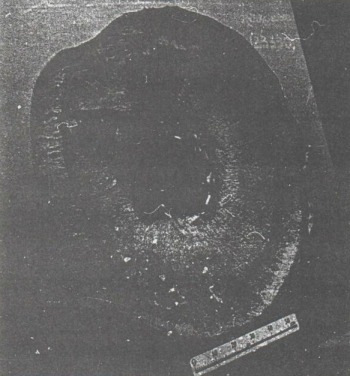
Backside of a 340 mm KC n/A plate, fired at with a 30.5 cm AP shell L/3.4.
The incendiary effect of our shells, as used now, should not be overestimated. The detonation flame is very short-lived, and only highly flammable objects are ignited by it. By contrast, the hot shell splinters can ignite cartridges and other readily combustible items.
Smoke and gas effects. Smoke generation in the ship’s interior by a detonating AP shell, particularly of high caliber, is quite considerable. Its removal depends on the efficiency [power] of the natural and artificial ventilation within the impacted spaces. The spaces are, disregarding the reduction in visibility, readily entered with a gas mask, since the ordinary particle filter will absorb it completely.
The effect of carbon monoxide gas (CO) generated by the detonation is generally not extensive. During the detonation of an AP shell, there is usually sufficient oxygen available that permits the burning [oxidation] of the generated carbon monoxide into harmless carbon dioxide (CO2).
The effect of combat substances depends on the type and quantity of the incorporated combat substance. This is generally of minor concern, but the effect may be sufficient to mandate the use of gas masks, since we are dealing with these effects in enclosed spaces. The use of combat substances must be expected, even if it is only an irritant substance [tear gas], and it makes the use of gas masks mandatory.
Comment to item 2. Effect of the projectile which disintegrates during penetration.
If an AP shell hits a comparatively [relatively] strong armor plate, or a plate at a disadvantageous impact angle, then a shell can disintegrate under these circumstances. The extent of this is demonstrated by the penetration curves.
The effect of such shots, during which the shell breaks up, can be quite variable, since this depends on data from behind the armor protection as well as on the surplus [excess] energy with which the shell and plate debris reaches the target. If important battle assets are installed in the proximity of the armor, such as barbettes, command stations, gun head walls, then even a shell with little surplus force can, under certain conditions, cause a decisive effect, e.g., a hit against barbettes.
If the armor wreckage has a certain excess energy, it can still perforate light armor, for example, torpedo bulkheads and light scarps, and thus, disregarding the higher velocity shell and plate [debris], contribute to greater internal effects.
The detonation effect of a broken shell is generally of no consequence; but if a shell is only cracked or if the shell fragments still have a certain degree of cohesiveness, then a partial detonation or partial explosion can occur, thus causing considerable destructive effects.
Comment to item 3. Effect of incoming shells at flat angles.
If a shell hits an armor plate at a very shallow angle, then the following events can be differentiated:
-
a) The shell is deflected, the plate receives a more or less deep dent,
b) the shell is deflected, the plate receives a fissure,
c) the shell is deflected, the plate is ripped open and debris reaches the target,
d) the shell is deflected, but the plate has a slit of considerable length,
e) the shell penetrates the plate, a long slit appears,
f) the shell penetrates the plate, a hole about the size of the shell is formed.
The destructive effect itself must be examined case by case, according to each location and position point of impact and according to each point of detonation where the shell explodes. A breaking-up of a shell [striking at high obliquity] on homogeneous material will only occur in very rare situations.
Comment to point 4. As to the fourth primary situation regarding shell effect, this is the case wherein a shell no longer causes a destructive effect behind the plate. Fissures and impending pot cover formation may occur, but it is important to note that no plate parts let fly that could cause destruction behind the plate, and that the watertight integrity of the plate is not threatened. The limit at which a plate affords such protection is called the "limit of protection" ["Schutzgrenze"]. This "limit of protection", at this time, has not been adapted to the penetration curves, since there is presently a lack of sufficient data to construct such curves.
The effect of this kind of shots is generally limited to the strong shock effect to the plate, and this can cause a loosening of joints and, thus, leaks can develop.
3. High explosive shells with base detonating fuze (Spgr. m. Bdz.).
a) Development and construction.
The high explosive shell with base detonating fuze was also improved.
Already, by the end of 1914, high explosive shells with base detonating fuze were provided with ballistic caps [windshields] in order to increase their range for land uses. The ballistic cap was positioned over the shell nucleus on already existing shells that had a head radius on the average of 10 D.
A further improvement was achieved by omitting the need to provide threading on the shell for ballistic cap attachment. The ballistic cap was attached to the shell by use of a soldered ring (ballistic cap base ring) (see drawing below). With this, the retention [of the ballistic cap] to the shell nucleus was considerably improved.
In order to facilitate the successful deployment of the new 38 cm high explosive shells with base detonating fuze, even against KC material, these shells are provided with a small [piercing] cap [note that the ballistic cap is placed over the shell piercing cap].
The explosive charge weight varies in the post-war [WWI] HE shells with base detonating fuze (with ballistic cap) from 4.1 to 6.7%.
The construction and development of the HE shells with base detonating fuzes in use at this time are demonstrated in the drawing below.
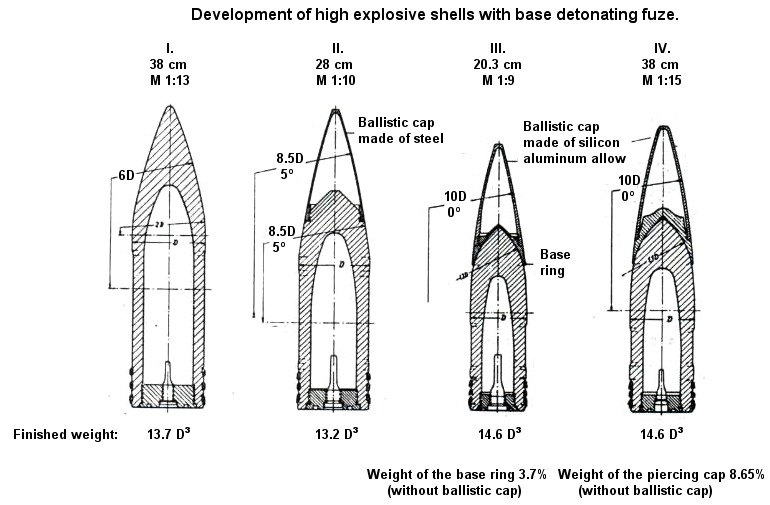
[Note by the editor: To determine the ballistic coefficient the Germans used the weight to diameter ratio expressed as W/D3.
For a 38 cm shell weighing 800 kg it would be: 800 / 3.83 = 14.579 = 14.6 D3.
For a 20.3 cm shell weighing 122 kg it would be: 122 / 2.033 = 14.583 = 14.6 D3.]
b) The effect of the high explosive shell with base detonating fuze.
The high explosive shell with base detonating fuze is an explosive shell with delayed action, built so strong that it can penetrate light armor intact and can detonate with full force in the target area.
This effect can obviously only unfold to its fullest extent, if the shell does not break up during penetration. During impact on stronger armor, the shell breaks up and then resembles the action effects of a disintegrating AP shell.
At [incoming] fire itself, as with AP shells (see there), three main characteristics need to be differentiated:
-
a) The effect of the "intact perforating shot".
b) The effect of the shell which breaks up during penetration of armor.
c) No action behind the armor plating occurs (protection limit).
The effects of the detonation of the high explosive shell with base detonating fuze is naturally greater than from an AP shell, if a clean [intact] penetration is made and, in particular, its effects on the explosive force on the splinter action. In regard to the incendiary effect, all information about the AP shell is valid, although the effect is somewhat increased over the AP shell because of the greater number of splinters.
The penetrating efficiency of the splinters lies approximately between the splinter effects from high explosive shell with nose detonating fuze and those of the AP shell. The sheet metal thickness [strength] (Wh material) that barely provides protection against splinters, i.e., is accordingly found between the curve values of the AP shell and that of the high explosive shell with nose detonating fuze (see following graphic illustration). These data are also derived from static shell detonations.
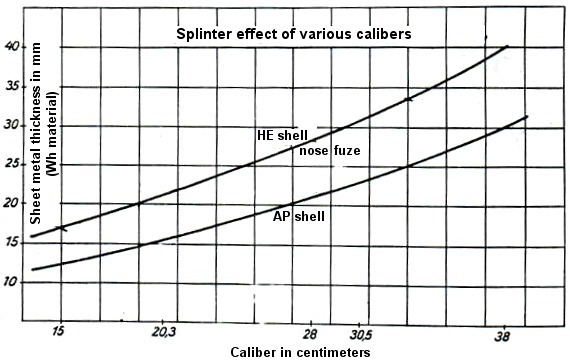
4. High explosive shells with nose detonating fuze (Spgr. Kz.).
a) Development and construction.
As a shell for the destruction of softer targets, high explosive shells with nose detonating fuze greater than 17 cm and of heavier caliber were first developed during the [First] World War. But these shells were not carried aboard during that war.
New high explosive shells with nose detonating fuze, for calibers up to 38 cm, were developed during the post-war time. These shells were of about the same construction as those developed during the war, although in the newest shells, the head was kept narrower and thinner.
The explosive charge varies from 6.9 to 8.55 %.
The construction of the high explosive shell with nose detonating fuze is shown in the following picture.
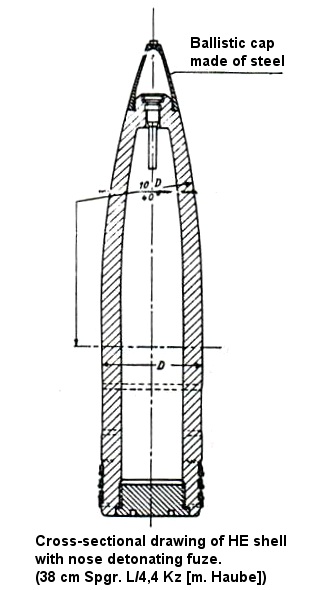
b) The effect of the high explosive shell with nose detonating fuze.
Based on the effect characteristics, the use of the high explosive shell with nose detonating fuze must be differentiated by:
-
1. Explosive effect.
2. Splinter effect.
3. Incendiary effect.
4. Smoke effect.
5. Gas effect (CO effect).
6. Combat substance effect (if incorporated)
The explosive effect of the high explosive shell with nose detonating fuze is by virtue of its high explosive charge factor (see section 5 "Comparative Summary of Shells") and very nature greater than the explosive effect of penetrating shells. However, it must be considered that the detonation happens within an enclosed space so that the effect of the released pressure cannot be fully exerted. At the moment of shell impact on larger surfaces, the surface receives a strong shock effect that is dependant [in terms of absorption] on the resistance capacity of the target. This shock effect is further magnified by the inherent energy of the shell's fragments. The magnitude of the combined force can be best deduced, i.e., seen in the following illustrations and from the summary (Table 1) regarding the "effect of the high explosive shell with nose detonating fuze against homogeneous armor material". For purposes of interpretation of the pictures, it must also be noted that the “featherings” of the penetrating shot hole reach sharply into the space, and, therefore, interfere seriously with repair and damage [flooding] control measures.
The effect of the high explosive shell with nose detonating fuze against unprotected targets (i.e., warships with unprotected or poorly protected side walls and superstructures), depends to a great extent on the momentary attitude at the point of impact. The size of the hole is often limited by, i.e., altered by, weight-bearing structures and braces that support the sheet metal. The size of the hole made by hits to the outer skin [of the hull] is considerably limited by the underlying frames. The influence of shell velocity on the size of the hole made in a thin hull wall is relatively minimal, while the effect on thin armor plate may be more marked.
A 15 cm high explosive shell L/4.5 with nose detonating fuze [fired] against a strongly built merchant vessel will produce a hole that is limited in width by the two frames adjacent to the impact area. Assuming a customary frame interval of 0.60 m, one can estimate that the hole's size will be 0.6 x 1.2 m. With a hit on the frame of lightly built ships, one can count on a greater extent of holing.
A 20.3 cm high explosive shell L/4.7 with nose detonating fuze, by comparison, will cause the removal of a frame and therefore, a hole of about 1.2 m can be expected. The height of the hole will commonly not extend beyond a single deck level.
From impacts of a 28 cm high explosive shell with nose detonating fuze on unprotected hull walls, the destruction of 2 to 3 frames can be counted on. The vertical extent of the hole will involve the destruction of both deck connections above and below the hit. The average size of the hole in a hull wall of normal strength (up to 18 mm ship construction steel) and a normal spacing of the frames will be approximately 2 x 3 m.
Experimental data on [the effect] on ships regarding the 38 cm high explosive shell with nose detonating fuze are not yet available. Based on the higher shell weight and the additional explosive charge weight, a considerable increase in hole size can be expected.
Comment for item 2. Splinter action.
The action of splinters is the principal effect of the high explosive shell with nose detonating fuze. The number of splinters can be obtained from the firing table.
The penetration efficiency of the splinters can be derived from the curve. These data have also been generated by the [static] detonation of shells.
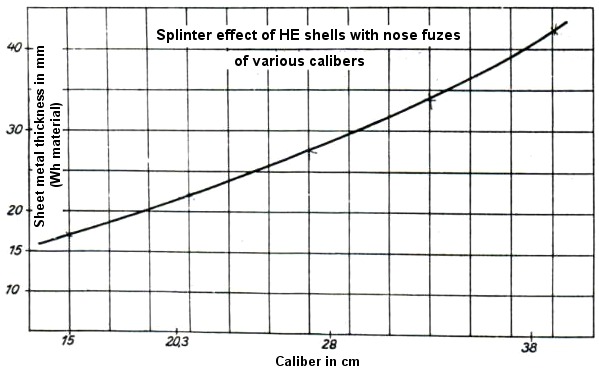
Comment to item 3. Incendiary effect.
The incendiary effect of the high explosive shell with nose detonation fuze based on the larger number of splinters could be greater. But one must consider that only a small portion of the splinters will hit flammable objects, since the detonation does not occur in an enclosed space.
Comment to item 4. Smoke effect.
The smoke effect is naturally greater based on the larger explosive charge, but the impediment from smoke is generally minor, since dense smoke can be rapidly dissipated.
Comment to item 5. Gas effect.
The gas effect (CO [carbon monoxide] effect) generally does not occur because the concentration is too low and because there is always sufficient oxygen to ignite [oxidize] the carbon monoxide into harmless carbon dioxide.
Comment to item 6. Combat substance effect.
If combat substances are built into the shell, an impediment caused by the combat substance may be felt when hits against superstructures and hull walls enter the interior of the ship. Even after sufficient ventilation, a so-called after- or wallpaper effect can occur (from the finely dispersed spray of the combat substance on floors and walls) that may still be a hindrance that can lead to mandatory gas mask use.
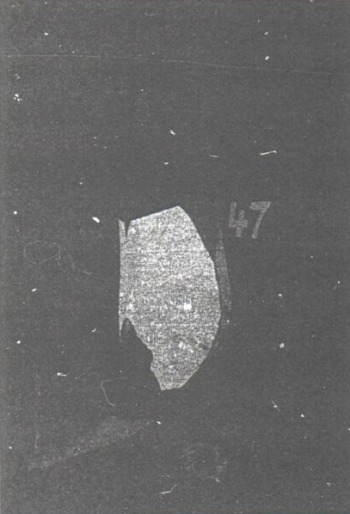
Hit from a 15 cm HE shell with nose detonation fuze [Spgr. Kz.] on the hull of a merchant ship.
(15 mm ship construction grade steel)
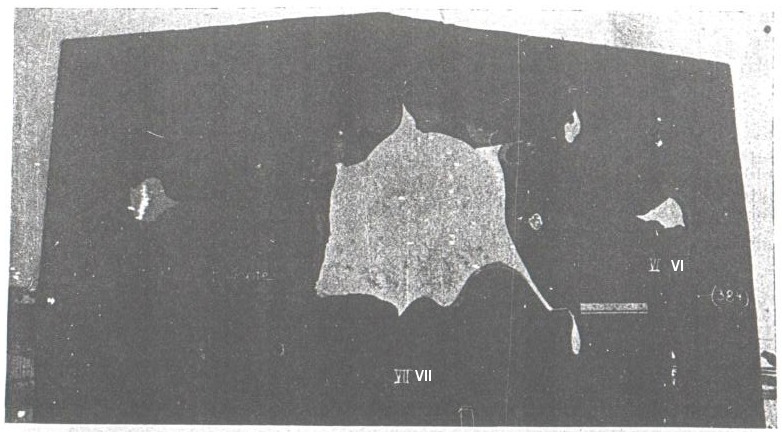
Shot VI – 12.7 cm HE shell with nose detonating fuze L/4.4 [fired] from 12.7 cm S.K. C/34 gun against 40 mm armor plate Wh n/A with [striking velocity] Vz = 700 m/s, [distance] E = 18.5 hm.
Shot V – 15 cm HE shell with nose detonating fuze L/4.5 [fired] from 15 cm S.K. C/25 gun against 40 mm armor plate Wh n/A with Vz = 700 m/s, distance = 44.5 hm.
Shot VII – 21 cm HE shell with nose detonating fuze L/4.3 [fired] from 21 cm S.K. L/45 gun against 40 mm armor plate Wh n/A with Vz = 400 m/s, distance = 152 hm.
Effect of the high explosive shell with nose fuze against homogeneous armor plate (hole size in "mm")

Explanation: Only single results by certain shots are recorded; limits of effects cannot be extrapolated [ascertained] from this.
5. Summary of the adopted shells and general [discussion] regarding the tactical use of these shells.
a) The accepted shells.
The following summary of the shells shall serve as an overview of the presently adopted major caliber shells used on ships. Details can be obtained from this summary regarding the development of shells presented here.

b) General comments regarding the use of AP shells.
The AP shell is the penetration shell. Only this shell makes it possible to get behind armor protection of about caliber strength or to achieve, with a flat hit, penetration of a more solid armored deck and cause severe destruction to vital parts in the interior of such a target. Even in cases where an intact penetration of an AP shell cannot be predicted [with certainty], an effect can still be expected due to serious damage caused by the fragmentation of the shell among the guns, barbettes, and furthermore, the command posts. Moreover, there can be hits against the weaker sections or parts of armor or against weak spots within armor. Even in very well protected ships one should always count on such weak spots, e.g., at plate butts [where two adjacent plates abut one another], plate corners [edges], the bow and stern armor, or adjacent armor protection.
Disadvantages of the AP shells are as follows:
The proportion of explosive charge is relatively small (approximately 2%), and, consequently, the resulting effect of the detonation is not all that great. (For details see Section III).
When hits are made on unprotected sections, the AP shells will penetrate these, and will often explode beyond the target [after passing through it] without causing serious damage. A proportion of the AP shells will actually go through soft targets without even detonating at all because there are insufficient impeding forces to activate the fuze.
A further disadvantage is that whereas HE shells with nose detonating fuzes cause severe cracks, a more or less caliber-sized, circular entry hole occurs that can be readily sealed.
c) General comments on the use of HE shells with base detonating fuze.
The HE shell with base detonating fuze is a projectile that will achieve greater explosive and splinter effects within the target than the AP shell when it is used against relatively weak armor or against an unprotected opponent or ship section. (The HE shell with base fuze has ~ 6% proportion of explosive charge in comparison with ~ 2% in the AP shell). Thus, the use of the HE shell with base detonating fuze is suggested when the opponent's combat assets are so poorly protected that the protection can be cleanly penetrated by the HE shell with base fuze. If such conditions are not met, the AP shell is to be preferred because the effects of a fully detonating AP shell are always greater than the wreckage effects of a broken-up HE shell with base detonating fuze.
The disadvantages of HE shells with base detonating fuse are generally the same as those of the AP shell, but its detonation effect is considerably greater since its explosive charge is much larger.
d) General comments on the use of HE shells with nose detonating fuze.
The HE shell with nose detonating fuze with its highly sensitive impact fuze [igniter] is especially fitting for use against soft targets or against superstructures.
With its high proportion of explosive charge (about 8%) and, therefore, its related very good splinter effects, [this shell] is still especially advantageous, when a large splinter effect becomes desirable, whether anti-personal effects or damage to splinter-sensitive weapons such as Flak or highly sensitive instruments such as range and aiming devices, search lights, and such.
The HE shell with nose detonating fuze is particularly effective against unprotected ships up to the size of destroyer leader vessels. Thus, with this shell it is possible to reach important parts such as engine and boiler compartments and cause flooding. The success of the latter depends on the strength of the waterline protection.
The disadvantage of the HE shell with nose detonating fuze is its relatively low penetrating effect. It is generally not feasible to penetrate far into the interior of larger ships, e.g., the engine room of a merchant ship, to cause serious damage. This characteristic limits its applicability, since in most battle situations the aim must be to truly reach the vital parts of the ship’s interior. Nose detonating impacts against fairly strong armor will, generally, only result in a certain splinter effect.
Introductory remark.
In the framework of this bulletin, the guns will be only considered primarily with regard to their comparable muzzle power. Such a comparison can be of special value concerning foreign gun equipment because such a comparison makes an analysis of applicable performance response possible. Analyses of issues related to numerous questions will not be discussed within this following framework: power increases, shot weight increase, caliber increase, improvement in penetration power and dispersal [scattering].
1. Comparison of power.
A comparison of the muzzle power of guns with different calibers can also be made by comparing the magnitude of the specific or relative muzzle energy [Wündungswucht] since caliber is independent of this criterion.
The relative muzzle energy is a product of:

The relative energies of comparable guns of our own and foreign navies are recorded in the illustration below. (As for barrel length, our guns also need to have the bore length [Seelenlänge] entered, while in foreign guns generally only this [bore length] is shown).
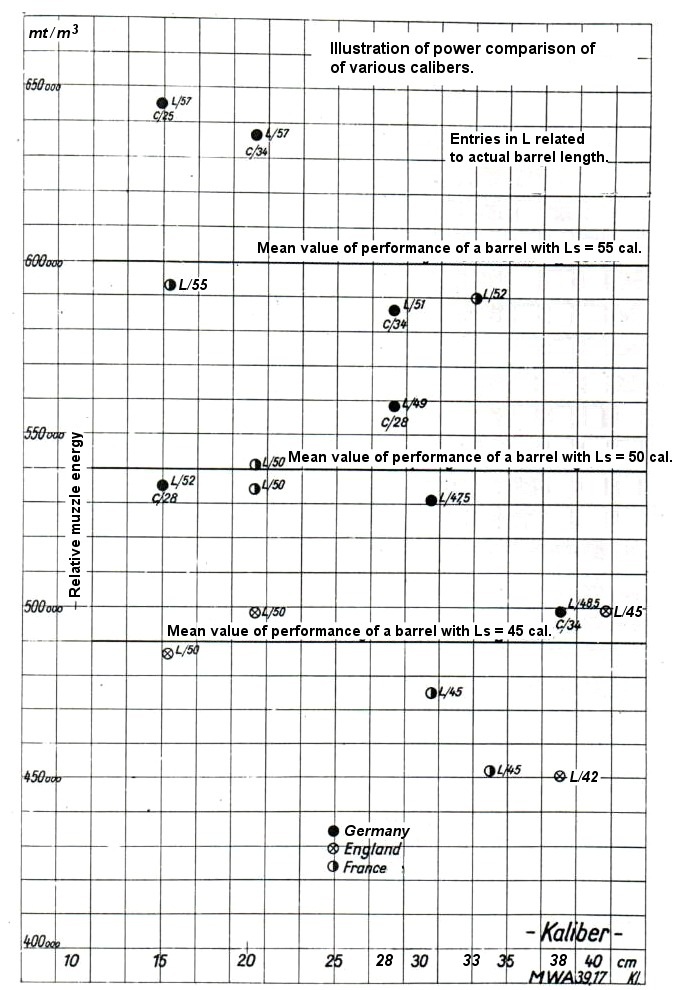
[Note by the editor: The 38 cm SK C/34 gun with a bore length of L/48.5, firing a shell with a muzzle velocity of 820 m/s, has a relative muzzle energy of: 27,400 mt / 0.383 = 499,343 mt/m3]
From this illustration, the power of one caliber with another can be compared, and, at the same time, a rough estimate concerning the power of a caliber can be derived.
In order to accomplish this comparative calculation, the mean values of several barrel lengths were entered that are based on experience of favorable internal-ballistic conditions. If one calculates the power of a gun’s relative energy based on a report and comes up with a value that is grossly above the mean value of estimated energy for a given barrel length, then either the Vo-scattering (and thus a 50% longitudinal scatter of the gun) is not very good or that the report of the power of a gun is erroneous. In the previous case, one can actually determine, if the power has been “over-reported” as too low.
2. The scatter of the guns.
Far-reaching conclusions cannot be drawn from comparing the muzzle momentum of various foreign guns that would offer the prospect of permitting the construction of particular individual scatter curves for these guns. Therefore, if no other reliable data are available, a generalized and normalized curve must be constructed that can predict hits from such foreign guns on a basis for the probability (see illustration below). This curve demonstrates the mean value of numerous experiments conducted on numerous calibers.
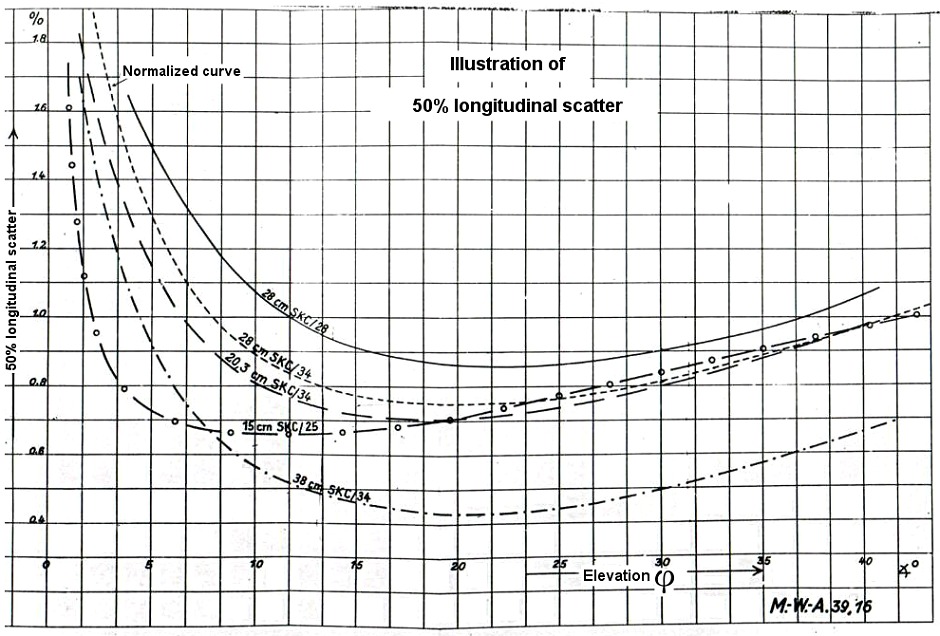
3. The rapidity of fire.
For comparisons of the fire rapidity of our own guns with foreign guns, generally, unless reliable reports are available, our own rate of fire values must be used for foreign guns, especially since the reports of foreign fire rapidity are commonly considered too unreliable. Very often, one cannot ascertain from these reports if these [ROF data] are theoretically determined maximum firing speeds, or if they were derived from training exercises or developed from actual firing range data. At the very best, the age of the particular gun's construction must be taken into account since a considerable improvement in firing speed can only be achieved by a complete reconstruction. For the comparative analysis of both parts [under consideration] we must consider our own practical firing experience from which the maximum rapidity of firing can be best determined.
The following values were applied:
| a) |
38 cm of battleships Bismarck-Tirpitz 28 cm of battleships Scharnhorst-Gneisenau 28 cm of Panzerschiffe 20.3 cm of heavy cruisers 15 cm of light cruisers |
2 shots/barrel/minute 2.5 shots/barrel/minute 2.5 shots/barrel/minute 4 shots/barrel/minute 7 shots/barrel/minute
|
| b) |
40.5 cm of Nelson 38.1 cm of Queen Elizabeth 34 cm of Lorraine 33 cm of Dunkerque 20.3 cm of Algerie 15.2 cm of Galissonniere |
2 shots/barrel/minute 2 shots/barrel/minute 2 shots/barrel/minute 2.5 shots/barrel/minute 4 shots/barrel/minute 7 shots/barrel/minute |
In the previous section only the expected effect of a single impact, such as the effect from an AP penetration, and splinter effects, et. al., were discussed. However, the general effect of shell hits on a defined target and the combined effect of several impacts has not yet been discussed. Furthermore, the interaction of several types of shells types among themselves is still missing. But the comparison of individual shell types with each other is particularly necessary in order to form guidelines for shell selection.
In order to formulate these guidelines, it is necessary to undertake an examination of the strengths [stability, rigidity, or solidness] of the opponent to be engaged under fire.
The following provisions are herewith provided:
-
a) Shooting at an opponent whose main armor protection does not generally allow penetration with one's own shells.
b) Shooting at an opponent in whom combat assets can be only partially destroyed by penetrating shells.
c) Shooting at an opponent whose main armor protection can be generally penetrated with penetrating shells.
d) Shooting at an opponent when apparent distances against vital parts are not a factor in achieving the full effect of shell penetration.
e) Shooting at an opponent when vital parts can be destroyed even by high explosive shells with nose detonating fuzes.
During a battle against a considerably stronger opponent, e.g., a light cruiser against a battleship, AP shells hitting the main armor will disintegrate without causing an effect. Hits against lighter superstructures such as funnels and masts will generally penetrate these without effect and detonate afterwards [some distance from the target]. Hits against unprotected parts of the ship, e.g., parts of the bow, stern and superstructures, will cause only minor effects in the ship's interior. Only hits in lightly armored parts, e.g., frontal and lateral walls of Flak positions, Flak fire-control stations, and other weakly protected places, will have a noticeable effect on combat efficiency [assets]. It is; therefore, better to select a high explosive shell with nose detonating fuze in place of the AP shell. It will primarily produce a noticeable splinter effect against personnel and against splinter-sensitive instruments such as AA weapons, optical instruments, search lights, and similar objects. Furthermore, there are immediate effects on Flak guns, munitions readiness lockers, and many other objects. Finally, a portion of the hits will also cause noticeable effects on unprotected parts of the ship, such as funnels, bridge structures, and masts.
High explosive shell with base detonating fuze will also disintegrate on strongly armored ship parts. However, hits against weakly protected parts (as long as an intact penetration is possible) or against unprotected parts will show a greater effect from the detonation in the interior, based on the nature of the shell.
Summary: It is recommended that the high explosive shell with nose detonating fuze be used against a heavily advantaged, solidly constructed opponent. But even with this type of shell and after multiple hits, serious danger to the opponent cannot be expected. However, his self-defense, in particular anti-aircraft and anti-torpedo boat defense, can be noticeably compromised (see footnote).
Footnote: In the year of 1937, the fire from destroyers against [the target battleship] “Hannover” confirms the present speculations. This barrage was accomplished under especially favorable battle conditions during a fire ambush of short duration that was conducted by 3 destroyers armed with 12.7 cm guns. Approximately 206 HE shells with nose detonating fuze hits were achieved from a distance of 22 to 27 hm [22,000-27,000 meters]. First of all, there were splinter effects against personnel and equipment. Furthermore, direct hits against combat assets such as Flak guns and Flak machineguns, munitions readiness lockers, aircraft, gun positions [fire control stations], funnels, bow sections, masts, and bridges, elicited noticeable effects. Certainly, the ship was heavily impacted and it was, for some time, adversely affected by its loss of defense capabilities, particularly against anti-torpedo boat and anti-aircraft defense.
However, it must be realized that all these many hits did not directly pose a danger to the ship itself. In order to achieve destructive success, additional weapon effects (from artillery, torpedoes, and bombs) would have been necessary.
Comment for item b. Shooting at an opponent in whom combat assets can be only partially destroyed by penetrating shells.
Firing at such an opponents, e.g., Panzerschiff against battleship, the effect of the AP shell needs to be considered first. Even if such shells cannot penetrate the main armor protection and remain whole; they will cause a noticeable effect in certain places of the ship. This could be at weak points in the armor, at butts, joints, or at edges, and also at weaker positions such as the intermediate artillery. The effect of AP hits, even when the shell breaks up, can also be very considerable, especially from hits against barbettes and gun positions. Here, the damage effect can lead to a complete loss of important combat assets. Flooding can also be achieved with hits at the waterline.
Thus, severe damage can be achieved with AP shells that, in case of hits of barbettes, can be decisive under certain conditions.
The use of HE shells with base detonating fuzes are of less value, since all hits against the main armor will have little effect, indeed, if there remains any effect at all. Only hits against relatively soft or unprotected places could elicit a greater effect due to the shell's larger explosive charge. This additional effect does, however, not warrant general use.
The use of HE shells with nose detonating fuze can certainly be called on for in specific tactical situations during battle in order to deprive the opponent's weapons deployment by damage to his targeting-, range-, and aiming devices, and furthermore, to disrupt his ability for air and torpedo defense.
In summary, in a battle with an opponent with only a slight advantage in staying power, the use of the AP shell is in the forefront because it will produce the heaviest damage.
Comment to item c. Shooting at an opponent whose main armor protection can be generally penetrated with penetrating shells.
First of all, a battle between heavy units is considered, e.g., battleship against a battleship of relatively equally strong armor and with comparable penetration capabilities. Here, the armor protection of the opponent will be penetrated by the “intact” AP shell, so that it can detonate in the vital spaces of the target’s interior. How far such an “intact” penetration of the armor protection extends is shown in detail in the back (see Section IV). However, there are additional effects of the AP shell that are outside the area of penetration that have been dealt with in a previous section.
Direct hits into vital parts can lead at least to the temporary loss of the impacted spaces [compartments]. In general, a permanent loss of the particular room [compartment] may occur, and often several adjacent spaces may become involved by collateral damage from splinters, smoke, and, in on some cases, with a combat substance [gas] (see footnote 1).
The experiences in the Battle of the Skagerrak [Jutland] demonstrated that even a complete annihilation can be brought about by a lucky hit (as in Invincible, Queen Mary, and Indefatigable, see Footnote 3).
If a battle involves lighter combatant forces, e.g., cruiser against cruiser, it must be ascertained if the critical combat assets can be readily accessed with the HE shells with base detonating fuse. If this requires the penetration of side protection, it must be considered if this can be accomplished even at relatively oblique positions of the opponent (approximately 40º toward or away). If it is possible to get at the combat assets with an HE shell with base detonating fuze, then it is the proper shell. If this is not the case, then the AP shell unquestionably comes into use just as it is in a battle of heavy units.
The use of the HE shells with nose detonating fuze can be employed in cases that are listed under b.
In summary, the use of the AP shell is certainly the primary shell in a battle with an opponent of more or less equal strength (see footnote 2). However, in battles involving light forces, the HE shell with base detonating fuze can be employed.
Footnote 1. The shooting and demolition experiments against, i.e., on the “Hannover”, provided a good picture in regard to the effect of hits. These experiments, among other items, showed the following:
-
1. Firing of 28 cm AP shell into the main engine room.
Effect: Immediate loss of the compartment due to great danger from steam, including complete loss of operation. Repairs are possible by lay-up time at shipyard.
2. Detonation of a 38 cm AP shell in the main engine room.
Effect: As in 1., but main engine is destroyed. Removal of engine is required.
3. Firing of a 28 cm AP shell into a boiler room [heating plant].
Effect: Immediate loss of the compartment due to danger from steam.
Entire operation is lost.
After containment of steam danger, only permanent loss of the hit boiler.
Repairs of the boiler require lay-up time in shipyard.
4. Detonation of a 38 cm AP shell in a boiler room.
Effect: as in 3. However, permanent loss of two boilers.
Repairs can be made only by the complete removal of the boilers during a lay-up time at a shipyard.
Footnote 3. These ships were dealing with barbette hits, and following this incident measures were undertaken for improving the security of the ammunition. Thus, to expect such an effect from hits with certainty will require penetration into the ammunition chamber itself.
Comment for item d. Shooting at an opponent when apparent distances against vital parts are not a factor in achieving the full effect of shell penetration.
In this section, the firing against only such opponents is dealt with, amongst whom a HE shell with nose detonating fuze would not already suffice to get at the vital parts (regarding the effect of HE shells with nose detonating fuze against armor, see summary on Table 1), e.g., Panzerschiff against cruiser.
Here it also needs to be ascertained if it is possible for an HE shell with base detonating fuze to penetrate the main protection.
If it is possible to enter the target with an HE shell with base fuze, so that it is detonated in the interior in vital spaces, it will result in the almost certain removal of the impacted rooms completely from combat uses. When firing with heavy calibers the adjacent compartments will be also drawn into the collateral damage. A few such hits will generally suffice to put the ship out of battle action and it is possible to bring about total destruction with a luck hit.
If it is not possible to penetrate into vital parts of the target with an intact HE shell with base detonating fuze, then the AP shell must be given preference.
The use of the HE shell with nose detonating fuze comes to bear when firing against superior forces for the demolition of air and torpedo defenses as well as for damaging range, targeting, and communications devices. Moreover, one can count on destruction near the waterline area of lightly protected ships.
Comment for item e. Shooting at an opponent when vital parts can be destroyed even by HE shells with nose detonating fuzes.
The aim here is to consider the bombardment of an enemy in which it is possible to get at its vital parts with the HE shells with nose detonating fuzes; so if the shot hits the enemy, can be penetrated in such a way that a splinter effect inside on the vital parts and water ingress into the main rooms is possible, e.g. battleship Tirpitz versus a cruiser, cruiser versus destroyer-leader-ship [Zerstörerführerschiff], cruiser versus merchant ship. Here the nose fuzed shell is to be given preference, since with this shell a great destructive effect can be achieved both inside and on the outer parts of the enemy. Even with a few hits of HE shells with nose fuzes, the number of which depends on the degree of inferiority, an annihilation success can be achieved, especially with hits in the waterline.
Also, there is an effect on morale when the HE shell with nose detonation fuze is used which is much more realistic [significant] in its appearance than that of the penetrating shells. This must be taken into account, especially, for example, in warfare on commerce.
In order to obtain effective fire against a far inferior opponent, it is recommended to augment the use of HE shells with nose detonating fuze with HE shells with base detonating fuze so as to ensure a greater depth of damage effects against engine, boiler, and ammunition compartments.
Summary.
The great importance of proper shell selection is quite apparent from the preceding presentation. Concurring opinions show that the most advantageous type of shell does not depend solely on the penetration power of our own artillery and the armor protection of the opponent. It [the selection of shells] may vary against the same opponent depending on distances that can influence greatly the penetration efficiency of our own piercing shells, and, in certain circumstances, also by the battle conditions. Also, the estimation of the opponent’s combat assets and the subsequent destruction of them that can be achieved with various types of shells cannot always be the same. In one case, a reduction of speed as opposed to destruction of artillery can temporally be a major concern; while in another scenario an obliteration that limits the opponent’s firepower may be the most pressing task at hand. Loss of masts and antennas, the bridge, far-reaching destruction of living quarters, ripping open the hull, especially near the waterline, loss of ventilation, heating, galley, and provision’s storage; all of these are losses the are of no great consequence in naval war when one is in the vicinity of a home support depot. However, they take on an entirely different dimension when far off shore in a distant sea. Also, a psychological effect may justify, in certain situations, the selection of a certain shell for a purely terror weapon choice. This applies, for example, with the instant use of heavy, nose detonating shells at the initiation of the engagement in order to immediately intimidate [disrupt] the hostile ship’s command, artillery, range, and position controls and, therefore, to greatly improve the free choice of our deployment of the decisive shell. Also, for other reasons, it may be appropriate to deploy the HE shell with nose detonating fuze because even at far distances missed shots can impose a considerable effect on morale by their lively splinter action. This also has a very considerable effect on morale. In conclusion, a clear understanding of the particular shell type must not lead to the presumption that the lack or scarcity of such a shell makes a battle hopeless. Each and every one of our shell types is so effective against most opponents that even the use of [putatively] less effective shells can be relied upon for pretty good results.
The guideline for deployment the artillery and shell choice is based on - see “Bases of Tactics” item number 12:
The primary aim of our artillery warfare must be the unification and intensification of our own artillery firepower effectiveness, and the immediate shut-down of the opponent’s firepower effectiveness, until final destruction of the opponent is achieved.
1. Introduction.
In the following discourse the main battle distance [Hauptkampfentfernung] will be understood as the distance, i.e., the range zone that is the most advantageous in a battle with a specific opponent, taking into account the penetration ability of the shells of both sides, the strength and arrangement of armor, and the probability of hits scored by both sides.
Therefore, the following investigation of the determination of the main battle distance is in the first place related to questions of [relative] shell effectiveness with respect to steadfastness [resistance to destruction of the target and our own ship] and in second place to questions regarding the possibilities of obtaining hits. During investigations of relative armor strengths [thickness and/or type of plate], questions of shell selection arise (AP or HE shell with base detonating fuze) for various battle distances and these must be taken into account.
The investigations of strength [solidity or steadfastness] are appropriately considered from two points of view:
-
a) From the viewpoint of vertical protection strength, i.e., it shall be investigated up to what distance the vertical protection can be penetrated.
The distance range within which the vertical protection can be effectively penetrated, i.e., affords no further protection, will be designated as “lower penetration zone”.
b) From the viewpoint of the horizontal penetration.
Here, we are dealing with the determination of the limit at which the horizontal armor protection can be penetrated by upward increases of the angle of fall.
This distance range shall be designated as “upper penetration zone”.
The upper penetration zone may, under certain conditions, begin only at such [great] distances that the probability of [achieving a] hit is quite low.
Therefore, in this regard, the hit probability must be especially taken into account.
In the following section, the individual penetration zones will be examined more closely.
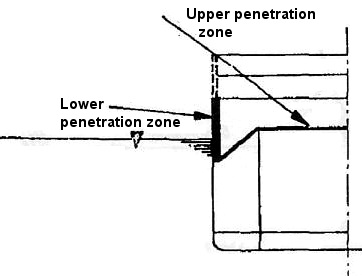
2. The “lower penetration zone”.
During examinations of the lower penetration zone two main cases must be distinguished.
-
a) Hits against barbettes, turret headwalls, and gun stations must receive separate consideration, because an effect can be expected even from a disintegrating shell against these areas.
This is because flying armor debris and shell fragments can elicit a considerable effect (this is especially true for turrets and barbettes, where there is a possibility that munitions are ignited); and furthermore, because these targets are not influenced by the opponent’s position [since they have curved or sharply angled faces].
In this case, one must always count on the opponent’s position being transverse to the direction of [incoming] fire, since most gun stations are rounded, the barbettes are round, and thus the opponent’s trained gun turrets will be directed perpendicular to the probable plane of hits.
The angle of impact obviously must be considered.
b) Hits against the main lateral protection. In most cases, here we are dealing with examining hits against combinations of armor. A serious effect from hits against lateral protection can only be expected if the main armor belt is penetrated by an intact shell that breaks up at least some other posterior armor barrier with enough force to generate a sufficient number of fragments and splinters.
Furthermore, it is important to examine the influence of the position of hits against the lateral protection in the calculation in order to gain an insight into the influence of one’s own ship position and to get an overview of the effect of the opponent’s position.
Calculation of the lower penetration zone.
The required numerical values for considering penetration efficiency cannot be ascertained directly from the penetration curves, but they will instead be determined by computations that consider the influences described above. A precondition for such a calculation is the knowledge of one’s own and the opponent’s armor and weaponry (data for opponent’s values are contained in tables in the booklets such as “weapons reports”). The procedure for this calculation shall be explained with the following practical example.
Example for the calculation of the lower penetration zone.
Chosen as example:
Battleship “Warspite” against a battleship of the ship-of-the-line type such as “Bayern”.
This example was chosen for security reasons in order to base it on a well-known armor arrangement and well-known gunnery performance. The present example is based on the assumption that the armored deck of the ship-of-the-line “Bayern” was reinforced to 70 mm and that the effects of hits in coal bunkers need not be considered, i.e., that the ship is powered by oil-heat. [Note by editor: coal bunkers accorded considerable additional protection against shell splinters, armor debris, and explosions].
Also, for evaluation of this example’s calculated values, consideration must be given to the fact that “Bayern’s” offensive performance is not only based on earlier 38 cm guns, but also on shells with the former lighter shell weight and obsolete shell shape. Only in the consideration of shell and armor quality are present qualities utilized because here there exists available supporting data that can be provided.
The effect of the provided gun and shell values is clearly recognized in the values that are obtained for the penetration of the lateral protection and the barbettes. It can be seen that the stronger armor protection of the “Bayern” can be penetrated from farther distances by the new guns and shells of the “Warspite” than can the weaker protection of the “Warspite” [by “Bayern’s” older guns and shells].
Therefore, no practical conclusions can be drawn from this example for our new heavy ships. This is meant only as an example and should be evaluated as such. (The values that are obtained for our modern material and ships are contained in booklets d to h).
1st part: Hits against barbettes.
Bases for the calculation of the lower and upper penetration zone[s]:
“Warpite” with 38.1 cm AP shells at 875 kg each having a [muzzle velocity] Vo = 745 m/s and barbettes made from 254 mm KC material. (Shells and quality of armor material must be considered equivalent to ours, since no data to the contrary are available). “Bayern” with 38 cm AP shells, L/4.4, at 750 kg and a Vo = 800 m/s and barbettes made from 350 mm KC material.
The penetration performance of the shells for various impact angles can be obtained from the penetration curves. The penetration curves are constructed for our own and the most important foreign naval guns, i.e., shells, in such a manner that for a given final velocity, Ve, and for a given impact angle, ω, the plate’s thickness can be obtained (for a “Grenzschuss” [which is a disintegrating/borderline shot at the limit of its effectiveness] or for an intact penetrating shot). The penetration curves were constructed from actual hands-on test data for KC material and Wh material. When using these curves, it must be noted that the abscissa (horizontal axis) of the impact angle of the penetrating curve is only identical with the specific angle of fall listed on the firing table when the target impact point lies horizontal (hence, hits on deck). For vertical targets, a position of 0 degree impact angle = 90º minus angle of fall.
Therefore, only the plate thickness that can be penetrated from a known distance (E) can be directly determined from the penetration curves. In the presented exercise it is not easy to determine from what distance the known target can be penetrated because making this determination is somewhat difficult in that the suitable range data are not readily available. A multitude of possibilities for penetration are obtained from the penetration curve for a given plate thickness, so long as only a single assumed final velocity Ve is entered for the appropriately designated impact angle. From this multitude of possibilities one should then be able to find the appropriate velocity by using the firing table. The computational determination of this distance would simply be a rough approximation that would be, moreover, a result which could be derived only inaccurately. It is better to obtain the penetration distance with the aid of the following graphic method (see sketch below).
The distance E (hm) is taken from the firing table. Furthermore, several estimated distances for a given target as well as the resulting impact angles for this distance are obtained from the firing table in order to calculate the necessary velocity for borderline, that is, intact penetration. These data are entered into the same graph to complete the curve. The first curve [Ve] demonstrates the actual available velocity, the second curve [Vg] [demonstrates] the velocity necessary for the penetration. The intercept of both curves determines the distance from which a penetration is still likely. A 50 by 50 hm interval calculation for both velocity curves is sufficient. Here is an example:
At [distance] E = 100 hm, [angle of fall] ω = 7º according to the graph of the firing table. Consequently α = 90º - 7º = 83º. For this impact angle, the limiting velocity is now determined from the penetration curve for 350 mm KC (limiting velocity, since the hit is against a barbette!). This results in Vg = 390 m/s. In the same way, points for 50, 100, 150 hm are determined. The determined points result in the Vg curve. The penetration distance E is derived from the intercept of both velocity curves as Eg = 243 hm. Hence, the barbette will be penetrated up to this distance.
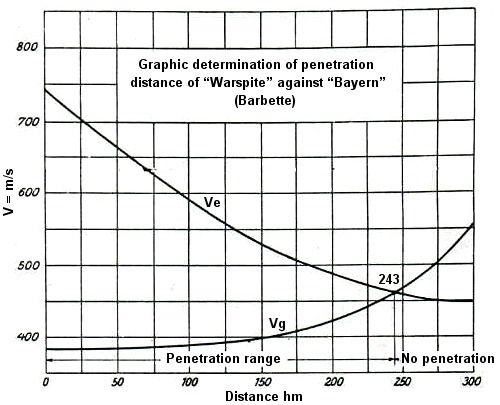
For the reverse case of “Bayern” against “Warspite”, the determination of the penetration distance is done in a similar fashion. This results in Eg = 227 hm. The barbette of “Warspite” will first be penetrated by the shells of the “Bayern” at a distance that is 16 hm less.
The limiting distances that were thus derived for the two cases will be entered in a table for further evaluation (see table attached).
2nd part: Hits against main side armor.
The following example of “Warspite” against “Bayern” shall now demonstrate how hits against the main side armor, i.e., armor combinations, are calculated. “Bayern” has a main perpendicular side armor protection of 350 mm KC material plus 70 mm of Wh material on a slanted deck escarpment that has an angle of 20º relative to the horizontal plane.
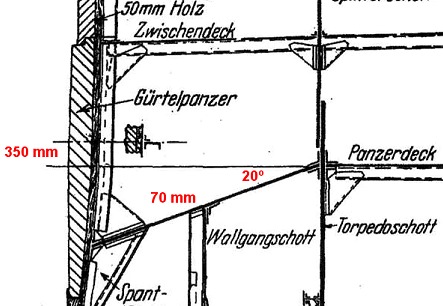
The determination of the penetration distance is also best done graphically. However, since we are dealing with penetrations of an armor combination, the penetration velocity for the combination must be calculated [differently];
This calculation is based on the formula:

Vh = Unknown velocity for the intact shell penetration of the combination [of armor plates].
Vh1 = The value of Vh for the front plate obtained from the penetration curve.
Vh2 = The value of Vh for the back plate obtained from the penetration curve.
Explanation of the formula. The derivation of the formula is based on the supposition that the force m/2 x V3 required for the penetration of a plate at a specific given angle is independent of the velocity that is present during a particular penetration. Therefore, the calculation is made as if the penetration of a plate is independent of the velocity, and that the same energy is consumed. This assumption can be made because range firing tests have confirmed that close approximations can be achieved with this calculation. Thus, this assumption implies that the intrinsic residual energy of the shell after penetration of the plate is equal to the impact energy of the shell less the energy necessary for penetration. Based on this argument [mathematical expression], calculations can be made to determine the residual velocity of a shell behind the plate that was penetrated with surplus energy. One must consider that during the penetration of the first plate, the [piercing] cap [Kappe] of the shell will be stripped away. Thus, the weight of the shell before penetration will differ from the weight of the shell after penetration of the plate. Of course, this fact need not be considered in the calculation, since the reduction in weight of the shell by cap stripping is entered twice in a reciprocal manner, and is thus cancelled out. By disregarding the weight reduction, the residual velocity (Vr) will initially be calculated as too low. This is because the penetration curve applies to shells with caps, but is too generous for equivalent conditions [wherein the cap has been stripped]. However, this error can be ignored since the shell’s weight is disregarded in the expression for determining the velocity calculation as a function of [post-penetration residual] force. The simplified expression results in:
Vh2 = Vh12 + Vh22
and from this:

It must be noted that the angle of impact to be entered is always the true impact angle α. This can be determined with the aid of the nomogram (nomograms and their use, see firing table pamphlet), while consideration is also given to angle of fall [trajectory], angle of position, and inclination of the plate. For the accuracy of the Vh curve, an approximate [interval] calculation 50 by 50 hm is sufficient. For example, when [distance] E = 100 hm, the opponent being square on [athwart], the angle of fall ω = 7º is obtained from the firing table. This means that the true impact angle is 83º at the surface of the KC plate and 27º at the slanted back plate.
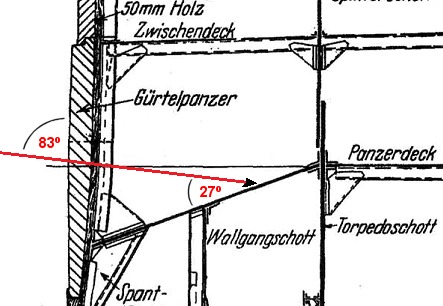
[Note by the editor: This is a conservative method of calculating penetration because shell yaw and relative trajectory changes caused by penetrating the first plate tend to degrade the shell’s ability to penetrate a subsequent plate that is set at a divergent angle with respect to the first plate].
From the appropriate penetration curves for this impact angle the following can be read:
Vh1 = 395 m/s
Vh2 = 245 m/s, and calculated from these values

Vh = 465 m/s
by which a point on the Vh curve is found. Further points are also calculated and added to the curve. The intersection of the Ve and Vh curves gives the penetration distance at E = 215 hm (see graphic below). This calculation for the armor combination results in the "intact through" values for both plates.
For other position angles, e.g. position 20º up or down, the calculation is also carried out. For the selected example (20º up or down) the penetration distance results from the intersection of the curves as E = 168 hm.
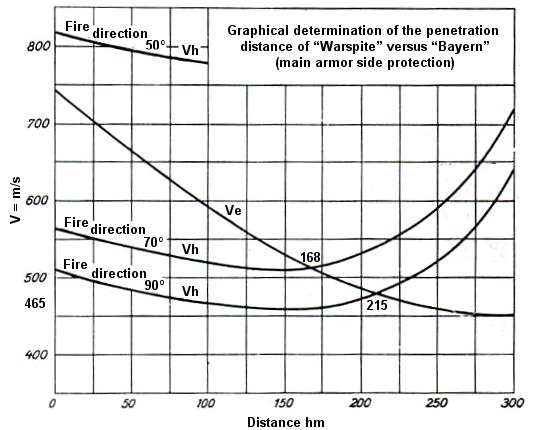
3. The upper penetration zone.
As was already indicated in this section’s introduction, a ship’s vertical, i.e., side protection should not be used to gauge its construction strength alone, for its strength must also be examined with regard to horizontal protection. This means that a distance must be determined from which [distance] range the horizontal protection can be penetrated [by a descending shell] – the "upper penetration zone" –. This examination is particularly important because weight considerations make it generally impossible to make horizontal protection strong enough so that it can provide protection against heavy caliber shells fired from long distances wherein the angle of fall is considerably greater.
Although the principles for calculating the upper penetration zone with the aid of penetration curves is the same as for determining the lower penetration zone, it must be pointed out that, due to the comparatively small impact angles in the penetration curves, they can only suggest a very rough approximation. The representation of the curves for these penetration data is already very difficult because small differences in material often produce large variations in effects. For example, simple differences in cap shape and hardness can have far-reaching effects, whereas in one case the intact shell penetrates the plate, and in the other, the shell is deflected. Moreover, the impact angle and impact velocity values that determine whether a shell is deflected or may still penetrate a plate are often so close to each other that differences simply cannot be distinguished with certainty. Additionally, it must be noted that these already comparatively low impact angles naturally make it more difficult to determine the firing directions (elevations!), which make this determination much more accentuated than at greater impact angles. This is especially prominent at the upper penetration zone wherein the penetration through several plates must to be calculated. Here, a situation may even occur where the shell lies at an angle to the line of flight [yaw effects], and therefore has to penetrate a plate with the exposure of a much greater cross-sectional circumference; an occurrence that is mathematically almost incomprehensible [difficult to fathom]. [This is a clear reflection of the R & D the Germans conducted in yaw effects that are detailed in ADM 213/951]
4. The probabilities of hits.
In the introduction to Section IV it is stated that a requirement exists for calculating the “main battle distance” that must include an evaluation of the reciprocal hit probabilities. This is accomplished by review and comparison of penetration efficiency as well as hit probabilities.
The predictability of hits does not depend only on gun and shell configurations, for it is also related to the other prerequisites of artillery performance. Factors such as range, firing, and bearing control installations, and, furthermore, the state of training, experience, and artillery officers’ abilities, must be predictable known. These factors cannot be mathematically measured, [although] their evaluation must be taken into account whenever possible since they may play a decisive role under certain circumstances.
In contrast to these not readily measurable influences on hit expectancy, the probabilities of hits can be discerned to some extent based on the scatter numbers given in firing tables [dispersion]. The result of this calculation is primarily limited by the supposition that the average point of impact lays in the center of the target. Therefore, it must be constantly remembered that far fewer hits should be expected during a battle [than this calculation indicates], and that the above-mentioned factors play an important role. However, the tabulation may serve well for comparison.
The calculation itself is based on the following considerations:
In order to propel all shots to the target, the sweep space would have to be 4 times as large as the 50% scatter area. Since longitudinal scatter is, at least generally, greater than the target size, the percentage of expected hits must be calculated with the aid of the probability calculation.
The hit percentage calculation will be done in a manner that, first of all, employs the 50% scatter figure from the firing table. This is multiplied by the scatter value of the battery (see following Table 3) in order to obtain the ”battery scatter number”, for only this number can be used in the calculation. Then, the relationship of the target’s size relative to the 50% battery scatter number, the “relative target extent”, must be determined as follows:

With the aid of the relative target extent, the percentage of hits for a given relative target extent can be obtained from the following Table 4.
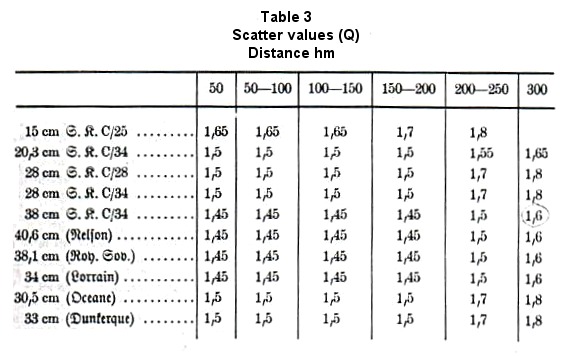
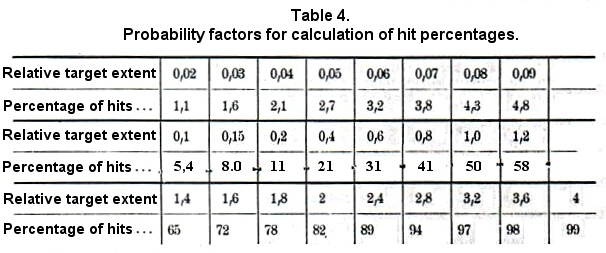
These numbers are contained in the accompanying pamphlet. The calculation of hits per minute is obtained from the calculation of the number of shots per minute x hit percentage, the product being divided by 100.
For the example of battleship “Bayern” versus battleship “Warspite”, the following hit probabilities were derived:
a) Battleship "Bayern".
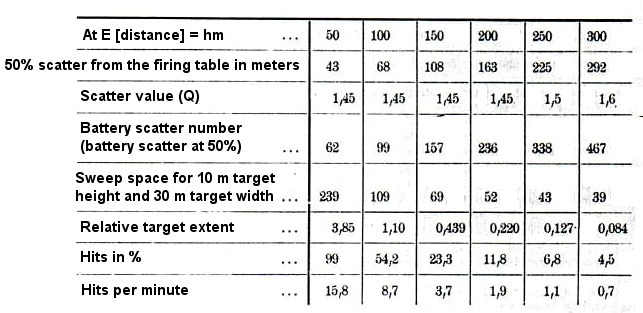
b) Battleship "Warspite".
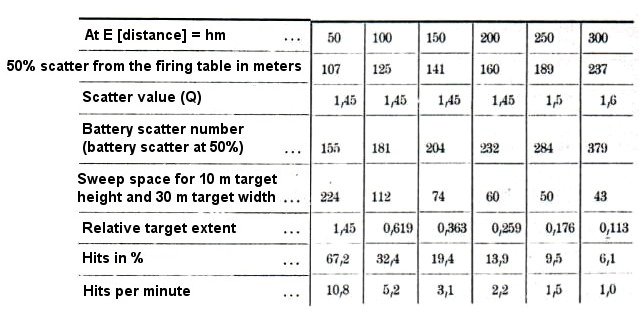
5. Determination of the main battle distance and shell selection.
How the appropriate main battle distance is determined, will also be demonstrated with the example of “Bayern” versus “Warspite”. The data used in previous descriptions will be examined, first of all, by comparing our and the opponent’s strength of construction. The supporting data for this will be, first of all, appropriately and orderly tabulated (see table attached), and then it will be determined at which distances the limits of the lower penetration zone lie for our own ship, as well as for the opposing ship. The example at hand provides evidence that the lower limit of our own side protection is quite high, lying at ~215 hm. However, this limit can be decreased considerably more by maintaining an advantageous angle of position for one’s own ship relative to that of the opponent’s line of fire. Only hits against barbettes, turrets, and command posts will still be able to seriously injure the ship. This danger remains up to 240 hm, and must be dealt with [accepted]. When considering the opponent’s strength of construction, it is apparent that the lower penetration zone limit for him is somewhat lower (at ~165 hm). The barbettes, etc., will be penetrated at a considerably greater distance (E = 230 hm). Since the opponent’s side armor can be penetrated at up to 165 hm (in a transverse [athwart] position!), while, as shown above, our own can still be penetrated at 215 hm, the weakness must be neutralized by maintaining one’s own [favored] angle of heading [position]. The limit of self-endangerment in the lower penetration zone can be diminished by 100 hm by holding a position angle of 30º.
After determining the lower penetration zone, the predictability of hits within these particular areas must be ascertained. Since the probability of hits in the present case is quite similar and advantageous, it can be observed that in regard to the lower penetration zone, the proper range for main battle distance is from 100 to 150 hm; although one’s own position angle of about 30º [relative] to the line of fire must be maintained.
After comparing the limit of the lower penetration zone, the same considerations have to be made for the limit of the upper penetration zone in order to arrive at a judgment here as well as to which distance ranges should be aimed for or avoided taking this into account. In particular, however, the chances of hitting must also be taken into account in the upper penetration zone, and it must be checked whether the use of ammunition is also in proportion to the expected success. From the present example it can be seen that the horizontal protection of the "Bayern" assumed here can be penetrated from about 140 hm, the opposing horizontal protection can sometimes be penetrated a little earlier, namely from around 115 hm. With regard to the upper penetration zone too, the area between 100 and 150 hm can be said to be favorable.
It must then be considered which shell types are appropriate for the individual distances. And, if the use of HE shells with base detonating fuze is an appropriate choice in one or another case, this determination is to be ascertained with the aid of the penetration curves according to the guidelines delineated in the previous section. Otherwise, it is reasonable to apply the guidelines for selection of shells provided in Section III.
In the example of “Bayern” versus “Warspite”, the shell choice is AP projectiles, even at distances that exceed the main battle distance. As is explained in the guidelines for shell selection, one can still expect some successes with AP shells against weakly armored sections or weaknesses in the armor construction. A transition to HE shells with base fuze is only appropriate when the AP shells have been expended. Guidelines for use of nose detonating shells are given in Section III.
In summary, the example of battleship “Bayern” versus battleship “Warspite” demonstrates:
The main battle distance is to be between 100 and 150 hm, at which an on and off [up and down] positional attitude between approximately 30 and 40 degrees must be closely observed.
At distances above 150 hm, penetrations of our own horizontal protection must be expected. The opponent’s fire effectiveness can be reduced by tactical procedures.
The range given as the main battle distance applies, first of all, when a quick decision is to be achieved by use of full force, since at this range, even the opponent’s side protection can be readily penetrated. However, if there is reason to believe that greater distances are more advantageous for one’s own expectation of hits than those of the opponent’s, e.g., because of superior bearing/range finders, it is recommended that, if the battle situation allows it, a greater battle distance be sought in order to bring one’s own increased expectations of hits to fruition. It is justifiable to strive for the higher distance range, since a success against the horizontal protection (up to 230 hm also against the barbettes) is possible here.
Selection of shells: AP shells [are] for all distances. The use of HE shells with nose detonating fuze comes into play, when, at great distances, a rapid success against the ship’s command (command tower!) or weapon deployment devices must be achieved. Furthermore, their use is appropriate in order to finish off a wrecked opponent by massive destruction of the hull walls.
Post-script: Further provisions for the determination of the main battle distance are evident in examples shown in booklets d to h. A supplement to these examples is planned.
Conclusions.
In general, it is again and especially emphasized that the present demonstrations about the determination of advantageous main battle distance and selection of effective shells in no way shall or should be construed as a firm and generally valid directive. The data regarding the opponent are often fairly unreliable [not certain enough]. This applies to the opponent’s gun performance as well as to the strength and arrangement of his armor shield. Furthermore, it [the uncertainty] applies to the quality and pro-forma value of the opponent’s AP shells and the quality of his armor. Here, values are submitted – namely, the same as those used in our newest shells and ships – that often, at least with regard to older hostile ships, appear to be too favorable.
In addition, the conditions during battle are too diverse, so that certain battle distances, which appear to be appropriately based on material and technical considerations, may not always be defined as the most advantageous during actual battle. Visibility, lighting, and observation capability, wind and weather conditions, a ship’s motion in a seaway, can all have great significance. The evaluation of one’s own state of training and the opponent’s, the trust [reliance] in one’s own art of shooting and the crew’s capabilities, a will for iron-strength endurance in the face of damage to one’s own ship, the performance capability evaluations of one’s own equipment, of the range finders and direction finders, all of these points must support the [commander’s] decisions for the type of [tactical] initiatives and execution of a battle plan. By reliance on one’s own know-how and trust in one’s own performance, the aim will be to prefer to choose a distance at the upper limit first, with the realization that at closer distances, even with an opponent having lesser shooting ability [art of shooting] and having fewer valuable personnel and equipment, may still understand how to make hits. Every important turn in a battle, be it the realization of one’s own superior fire power, clumsy handling or glaring lapses by the opponent, must be instantly countered with the most effective and immediate measures, even when they may not always be in accord with the viewpoints of tactical doctrine. Within this point of view, it must be the aim that the best method for avoiding heavy self-damage [survival] is the immediate destruction of hostile firepower, and only in special cases can one’s own tactical measures be substituted for this goal. [For example,] if the opponent develops a heavy list, the chances of destructive hits are immediately and substantially improved against the low side by destructive hits against the exposed armored deck [offering its surface], although the exposure of the high side also greatly increases the chances for hits below the hostile ship’s side protection. In both instances, the importance of vertical armor plating is negated, and this [change of target attitude] can have decisive consequences for selecting battle distance and choice of shells. If the opponent lies non-maneuverable in place, or is at least heavily impaired in his speed, while his firepower is still intact, then the likelihood of one’s own hits at great distances increases. However, if the opponent’s firepower collapses, a heavily armored opponent will be difficult to sink without the expenditure of large amounts of ammunition as long as he floats on an even keel, and thus still has a well-protected waterline. Now, the HE shell with nose fuze takes preeminence against unprotected parts of the waterline in order to achieve heavy flooding by rupturing of the waterline. Under certain circumstances, one’s own torpedo weapon or heavy aerial bombs can be employed in order to conserve one’s own heavy barrels and munitions for subsequent actions.
The present sections can and shall provide, for all these reasons, only foundations and viewpoints that shall facilitate the arrival at the right decisions by the leadership, commander, and artillery officer. Under no circumstances should the conclusion be drawn from this text that an artillery battle could not be successfully executed when it is not possible to choose the proper battle distances or when other [than prescribed] shell types must be utilized. The undeniable will for victory and a relentless effort to destroy the opponent contribute more importantly to success than does the materiel-technical favorite selection of distance and shell. But for preparatory considerations, for tactical training, and for battle preparation, the leadership should know which requirements at the materiel-technical level must be taken into account.
Format for a firing table graphic display.
Penetration curves of an armor-piercing shell against plates with a hardened surface.
Penetration curves of an armor-piercing shell against homogenous armor plates.
Overview of the example of the Battleship “Bayern” compared to the Battleship “Warspite”.
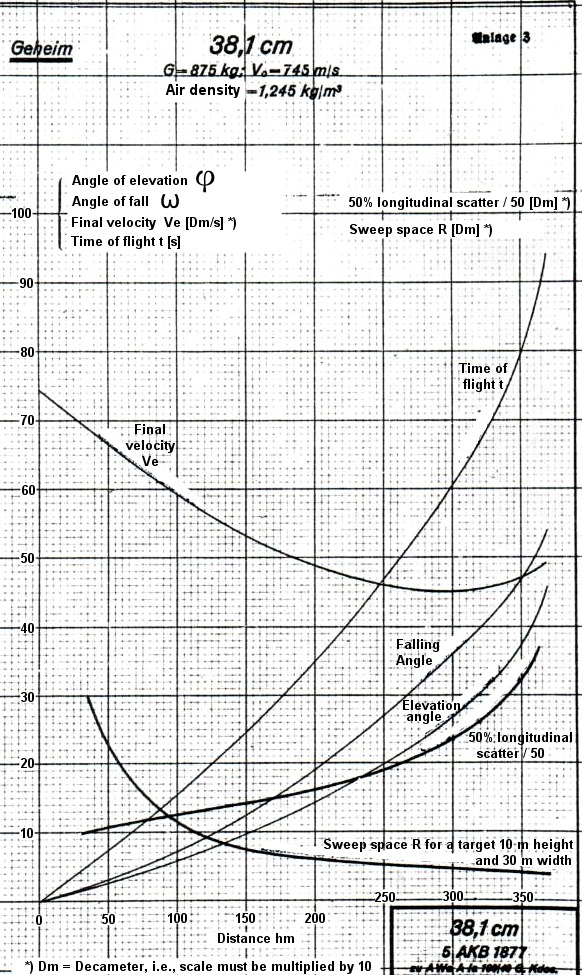
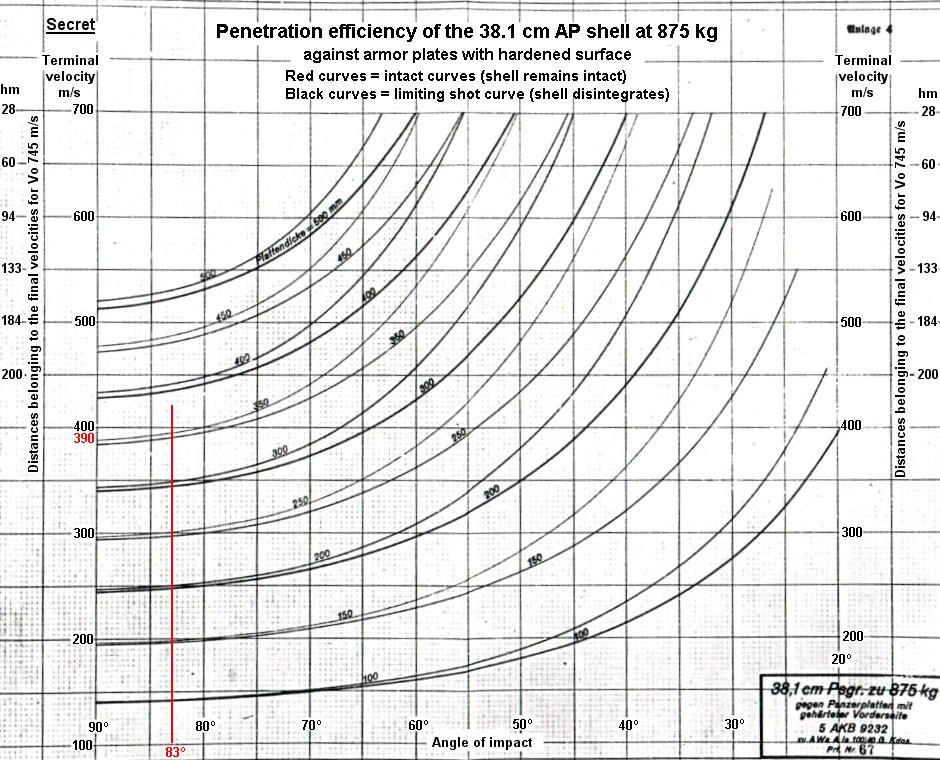
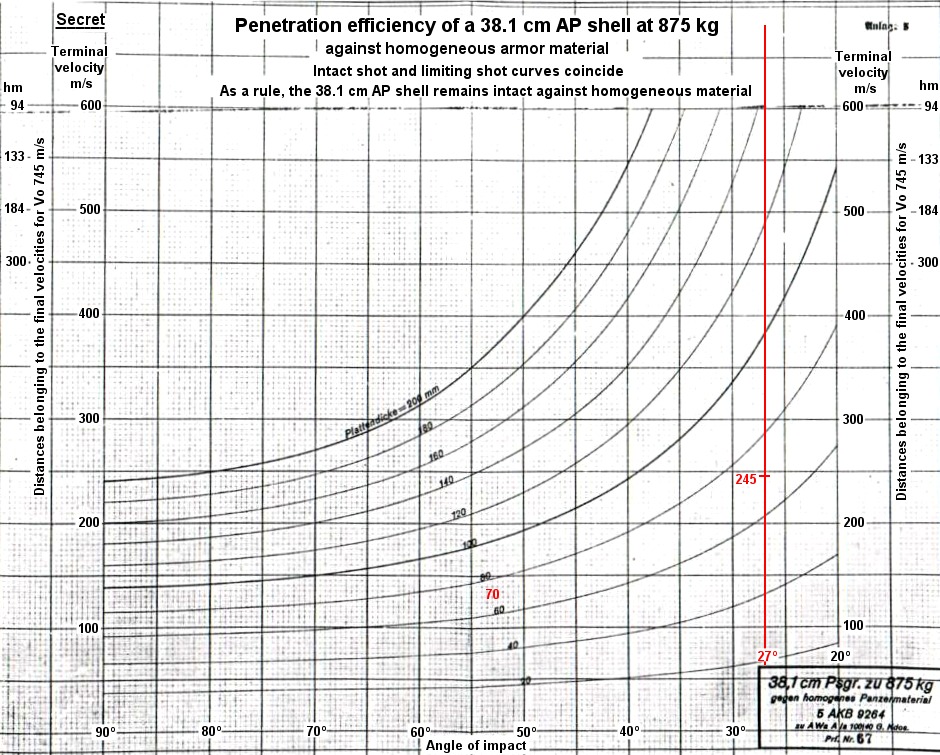
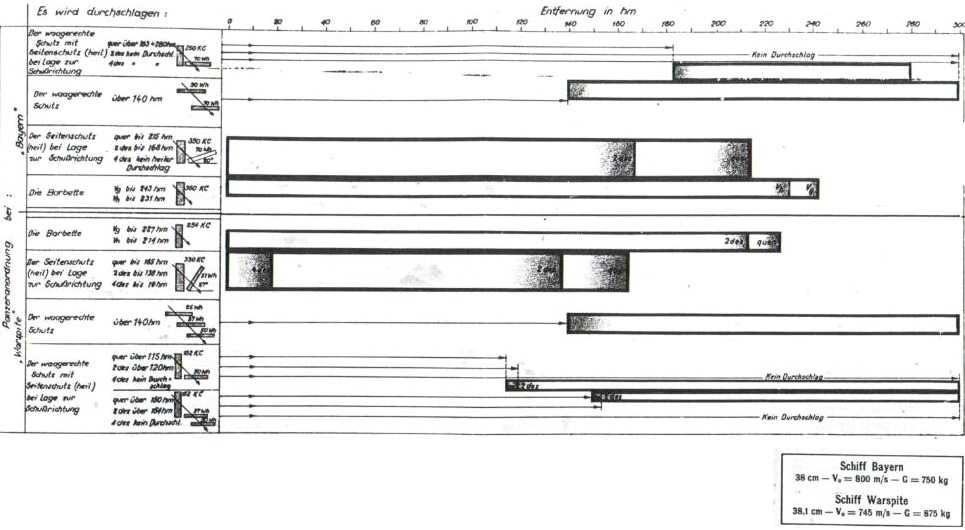

| Home Guestbook Quiz Glossary Help us Weights & Measures Video Credits Links Contact |
